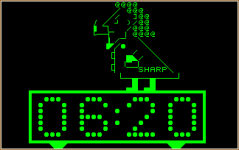...is this board found in the MZ-80A or any other of the MZ machines?
Certainly an MZ-80A board, even if it existed would be unlikely to work; that machine is from a completely different series.
Oh, this is news to me. I thought the MZ80B was the 'graphics' version of the A, amongst other things. How would you 'add' graphics?
Nope, the 80B is an entirely separate machine.
The naming of the
models is confusing, but, pre-X1, you have basically two separate series:
- "Hobby": MZ-80K (and K2 and K2E), MZ-80C, MZ-80A, MZ-1200, MZ-700, MZ-1500, MZ-800.
- "Business": MZ-80B (and B2), MZ-2000, MZ-2200.
Of the hobby series, only the MZ-1500 and MZ-800 had bitmap graphics; all the rest had only text, Hudson manufactured programmable character generator (PCG) kits for the earlier ones that let you change the character definitions, and these were quite popular.
The MZ-80K had two optional cards to provide RAM for 320×200 monochrome graphics overlaid over the text screen; the
MZ-80BG, which provides 8K of RAM and is definitely the one you have, and the MZ-80BGK, which provides another 8K and goes into an expansion slot on the back of the machine, rather than being internal.
Unlike the hobby series, the
MZ-80B character set is fairly limited because they dropped about 95 graphics characters and substituted reverse-video characters for them instead. Comparing that character set with the expected output image you posted:

it's pretty clear that the program you're running is designed for the the hobby series, rather than the business series, since it's a character display using characters that don't exist in the MZ-80B character set. In fact, you can see that along the back of the bird you're getting a reverse 'm' on your machine, which is character code $ED on the MZ-80B, and looking that code up in the
MZ-80K character set you'll find it's the diagonal line in the image above.
So the problem you're seeing there is nothing to do with your graphics memory board and whether or not it's working, but with the program you're running. What you need to find (probably in that manual someone pointed you to) is a program that generates graphics and see if that works.
But I am still not sure how the screen display switches from alpha to graphics. It has to do it on a character sell by character cell basis - so I am just wondering whether a control character gets stored into the character cell indicating that the cell should be filled with graphics as opposed to text?
My understanding is that the graphics overlay the text, so you store just character codes (probably not the same as ASCII codes) into the frame buffer for the character display, and you separately store bitmaps in the frame buffer for the graphics display, and those will be overlaid on top of the characters.

